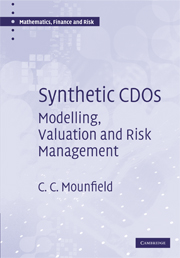Book contents
- Frontmatter
- Contents
- Preface
- Acknowledgements
- 1 A primer on collateralised debt obligations
- 2 Modelling of obligor default
- 3 Valuation of credit default swaps
- 4 Credit indices
- 5 Valuation of default baskets
- 6 Valuation of synthetic CDOs
- 7 Phenomenology of the standard market model
- 8 Risk quantification of synthetic CDOs
- 9 Implied and base correlations
- 10 Extensions of the standard market model
- 11 Exotic CDOs
- 12 Correlation trading of synthetic CDO tranches
- 13 Risk management of a portfolio of synthetic CDOs
- 14 Hedging simulation of structured credit products
- Appendix A Explanation of common notation
- Appendix B Simulated annealing
- References
- Index
1 - A primer on collateralised debt obligations
Published online by Cambridge University Press: 06 July 2010
- Frontmatter
- Contents
- Preface
- Acknowledgements
- 1 A primer on collateralised debt obligations
- 2 Modelling of obligor default
- 3 Valuation of credit default swaps
- 4 Credit indices
- 5 Valuation of default baskets
- 6 Valuation of synthetic CDOs
- 7 Phenomenology of the standard market model
- 8 Risk quantification of synthetic CDOs
- 9 Implied and base correlations
- 10 Extensions of the standard market model
- 11 Exotic CDOs
- 12 Correlation trading of synthetic CDO tranches
- 13 Risk management of a portfolio of synthetic CDOs
- 14 Hedging simulation of structured credit products
- Appendix A Explanation of common notation
- Appendix B Simulated annealing
- References
- Index
Summary
Credit – Derived from the Latin verb credo meaning ‘I trust’ or ‘I believe’.
Introduction
In this book we will introduce and describe in detail synthetic collateralised debt obligations (or synthetic CDOs for short). Synthetic CDOs are a sophisticated example of a more general asset class known as credit derivatives. In their simplest form credit derivatives facilitate the transfer of credit risk (the risk that a counterparty may fail to honour their outstanding debt obligations such as paying coupons or repaying principal on bonds they issued) between different counterparties to a trade. The rationale for trading credit derivatives is to allow this risk to be transferred efficiently between counterparties, from those who are unwilling or unable to hold it, to those who want it. This chapter will introduce some of the important credit derivative products that will be analysed in detail later in the book. The chapter will also introduce the financial engineering concepts that underlie synthetic CDOs.
Section 1.2 introduces the concepts of securitisation and tranching. These are the key financial innovations that underpin CDOs and indeed much of structured finance technology. Section 1.3 then provides an overview of some of the most common credit derivative instruments. These include credit default swaps, credit indices and most importantly synthetic CDOs.
- Type
- Chapter
- Information
- Synthetic CDOsModelling, Valuation and Risk Management, pp. 1 - 24Publisher: Cambridge University PressPrint publication year: 2008

